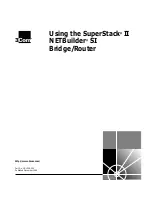
31
Configuring traffic policing, traffic
shaping, and rate limit
Overview
Traffic policing traffic shaping, and rate limit are QoS techniques that help assign network resources,
such as bandwidth. They increase network performance and user satisfaction. For example, you can
configure a flow to use only the resources committed to it in a certain time range. This avoids network
congestion caused by burst traffic.
Traffic policing generic traffic shaping (GTS), and rate limit control limit the traffic rate and resource
usage according to traffic specifications. Once a particular flow exceeds its specifications, such as
assigned bandwidth, the flow is shaped or policed to make sure that it is under the specifications.
You can use token buckets for evaluating traffic specifications.
Traffic evaluation and token buckets
Token bucket features
A token bucket is analogous to a container that holds a certain number of tokens. Each token
represents a certain forwarding capacity. The system puts tokens into the bucket at a constant rate.
When the token bucket is full, the extra tokens cause the token bucket to overflow.
Evaluating traffic with the token bucket
A token bucket mechanism evaluates traffic by looking at the number of tokens in the bucket. If the
number of tokens in the bucket is enough for forwarding the packets, the traffic conforms to the
specification, and is called "conforming traffic." Otherwise, the traffic does not conform to the
specification, and is called "excess traffic."
A token bucket has the following configurable parameters:
•
Mean rate at which tokens are put into the bucket
—The permitted average rate of traffic. It
is usually set to the committed information rate (CIR).
•
Burst size or the capacity of the token bucket
—The maximum traffic size permitted in each
burst. It is usually set to the committed burst size (CBS). The set burst size must be greater than
the maximum packet size.
Each arriving packet is evaluated. In each evaluation, if the number of tokens in the bucket is enough,
the traffic conforms to the specification and the tokens for forwarding the packet are taken away. If
the number of tokens in the bucket is not enough, the traffic is excessive.
Complicated evaluation
You can set two token buckets, bucket C and bucket E, to evaluate traffic in a more complicated
environment and achieve more policing flexibility. For example, traffic policing uses the following
parameters:
•
CIR
—Rate at which tokens are put into bucket C. It sets the average packet transmission or
forwarding rate allowed by bucket C.
•
CBS
—Size of bucket C, which specifies the transient burst of traffic that bucket C can forward.
•
Excess burst size (EBS)
—Size of bucket E, which specifies the transient burst of traffic that
bucket E can forward.
Содержание FlexNetwork 6600
Страница 106: ...99 Rule s If match acl 2000 Behavior behavior_1 Accounting Enable 28529 Packets ...
Страница 146: ...139 Figure 53 Implementing HQoS through interface level hierarchical CAR ...
Страница 147: ...140 ...
















































